Dynamic collision detection method and device
A collision detection and dynamic technology, which is applied in the field of virtual reality technology-assisted product design and analysis, can solve problems such as failure to meet target requirements, difficulty in collision detection, and not very suitable for virtual maintenance simulation, etc., to achieve simple calculation, good fit, The effect of less calculation
- Summary
- Abstract
- Description
- Claims
- Application Information
AI Technical Summary
Problems solved by technology
Method used
Image
Examples
Embodiment 1
[0085] Figure 8 is the overall execution frame diagram of collision detection provided by the embodiment of the present invention, such as Figure 8 shown, including:
[0086] 1) Preparation for simulation
[0087] At the beginning of the virtual maintenance scene, the virtual maintenance simulation system will automatically encapsulate the maintenance personnel to form a motion structure composed of multiple capsules c_human[a] (a is the number of human capsules). Due to the particularity of the virtual maintenance scene, by default in the maintenance scene, the first moving object is the human body of the maintenance personnel. Therefore, the first collision detection should be performed on the moving human body.
[0088] Although the capsules in the human body structure can do multi-degree-of-freedom movements, due to the limitations of the joints of the moving human body, these capsules cannot leave a certain area. The boundary of this region is the envelope surface fo...
Embodiment 2
[0096] Figure 9 It is a flow chart of the execution process of type A collision detection provided by the embodiment of the present invention, such as Figure 9 As shown, the type A collision detection is essentially the first level of collision detection, which mainly determines whether the maintenance object in the maintenance personnel’s accessible space capsule collides with any capsule in the human capsule structure. If not, Then there is no need to perform subsequent collision detection process, that is, type B collision detection, if there is, set the enumeration type testType=B, and this value will cause type B collision detection to be performed in the next refresh detection.
[0097] A type of collision is specifically implemented as:
[0098] Step A1: Traverse all maintenance object capsules in the scene, and judge whether they collide with reachable space capsules. If there is no collision with the accessible space capsule, there is no need to perform the next s...
Embodiment 3
[0104] Figure 10 It is a flow chart of the B-type collision detection execution process provided by the embodiment of the present invention, such as Figure 10 As shown, the type B collision detection is essentially a secondary collision detection, which mainly performs collision detection between the human capsule and the corresponding maintenance object capsule group.
[0105] Type B collisions are specifically implemented as:
[0106] Step B1: traverse the human capsule tree, and determine whether to perform secondary detection according to the information stored in the human capsule in the Type A test. For the human capsules that have corresponding maintenance object capsule groups, step B2 is performed.
[0107] Step B2: Iteratively perform collision detection between the maintenance object capsule group and the corresponding human capsule. If some collisions are established, the corresponding collision information will be output to the virtual maintenance simulation ...
PUM
 Login to View More
Login to View More Abstract
Description
Claims
Application Information
 Login to View More
Login to View More - R&D
- Intellectual Property
- Life Sciences
- Materials
- Tech Scout
- Unparalleled Data Quality
- Higher Quality Content
- 60% Fewer Hallucinations
Browse by: Latest US Patents, China's latest patents, Technical Efficacy Thesaurus, Application Domain, Technology Topic, Popular Technical Reports.
© 2025 PatSnap. All rights reserved.Legal|Privacy policy|Modern Slavery Act Transparency Statement|Sitemap|About US| Contact US: help@patsnap.com



